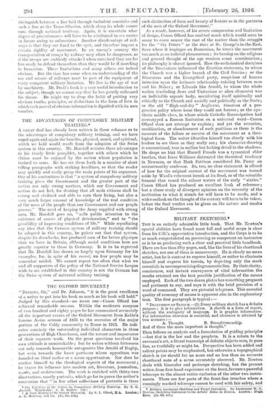MILITARY SKETCHING.*
THIS is an entirely admirable little book. That Mr. Newton's special abilities have found most full and useful scope is clear from his C.O.'s appreciative introduction, and the Corps is to be as much congratulated on possessing so competent an instructor as is he on producing such a clear and practical little handbook. There are less than fifty pages, and, like the lines of his shorthand sketches, not one of them is unnecessary. Ho is clearly no mean artist, but he is content to express himself, or rather to eliminate himself and express his terrain, by depicting only the stark essentials in uncompromising diagrammatic line. By their clarity, conciseness, and instant conveyance of vital information the results attained are the best possible justification of the means employed. Each of the two dozen plates has something pregnant and pertinent to say, and says it with the brief precision of a word of command. They are pictorial telegrams. This essential quality of economy of means is apparent also in the explanatory text. The first paragraph is typical :- " DEFINITION OF SNETCH.—(1) Every military sketch has a definite purpose ; it is to give information. A Act& is a form of report, without the ambiguity of language. It is graphic, information. For information clearness is essential, and clearness is attained by two avenues :- A. Thought. B. Draughtsmanship. And of these the more important is thought."
Then follows an analysis and a formulation of guiding principles —but that is the law and the prophets. It is a return to the caveman's art, a literal transcript of definite objects seen, in pure line, as truthfully as might be. Perspective has been added and salient points may be emphasized, but otherwise a topographical sketch is (or should be) no more and no less than an accurate shorthand note of a scene accurately observed. Mr. Newton deals with binocular and periscope sketching, but the present writer, from first-hand experience at the front, favours a powerful telescope to the almost entire exclusion of the other two instru- ments. There are few parts of the front-line trenches where a cunningly masked telescope cannot be used with fair safety, and • Military Landscape -Sketching and Target-Indbuttion. By Lieuteriant.W. Newton, Sketching Instructor to the Artists' Rides in France, London ,1411. Rees. Lls. Gd. net.] all circumstances it is far superior to field glasses• for deter- mining the plane that an object is in,-for seeing into anything (a wood, a village, or a building), and of course for accurately noting details. Also a telescope can usually be so fixed up that you can sketch with one eye to the glass and the other on the paper. Amongst some rules for draughtsmanship that are admirable, the author includes one that seems to be rather a counsel of perfection. Bays he : " Throw away your iridia- rubber." That is .a hard saying. It is analogous to the abolition of that invaluable word of command : " As you were ! " from the parade-ground vocabulary of a New Army subaltern. Both are the swift correctors of mistakes and slips, or rather, elimi- nators, "washouts." They are the negative sheet-anchors of adventurous inexperience. Having praised by this faint damning, it only needs to be added that the slim little book could slip easily ten at a time into one's tunic pocket.



































 Previous page
Previous page